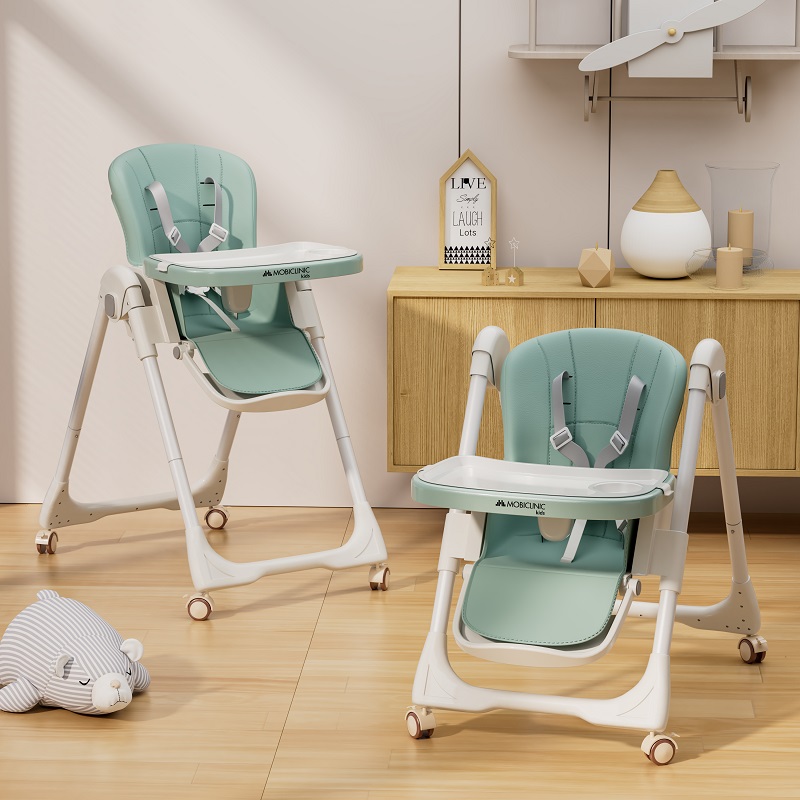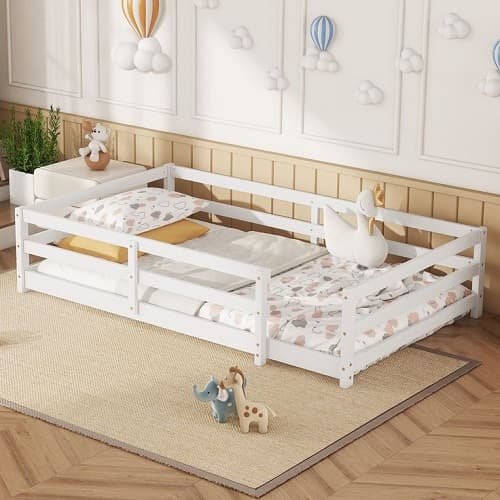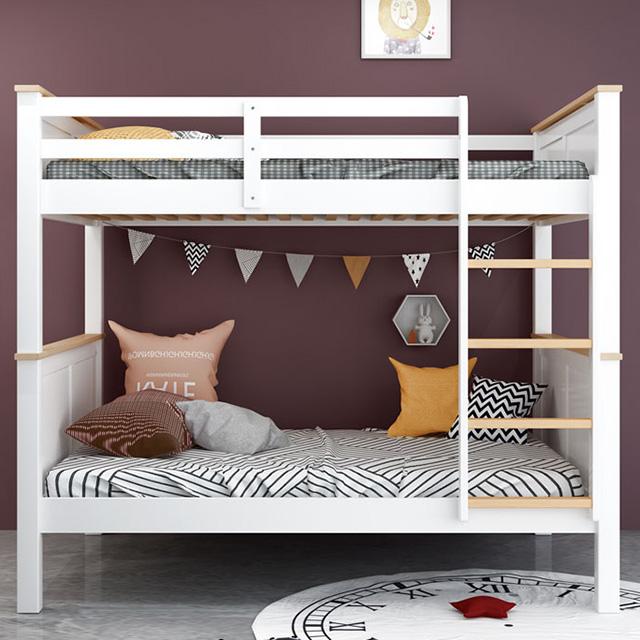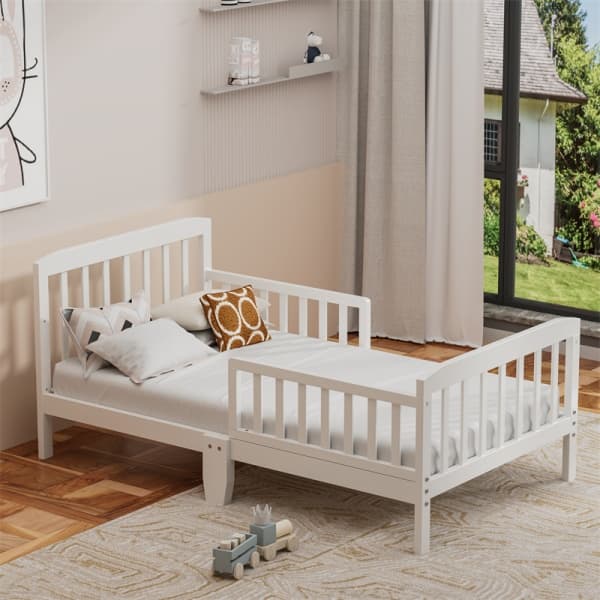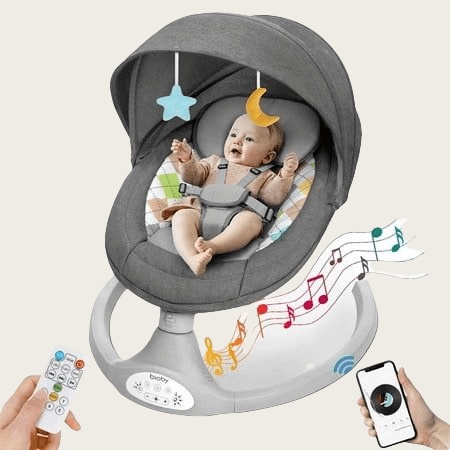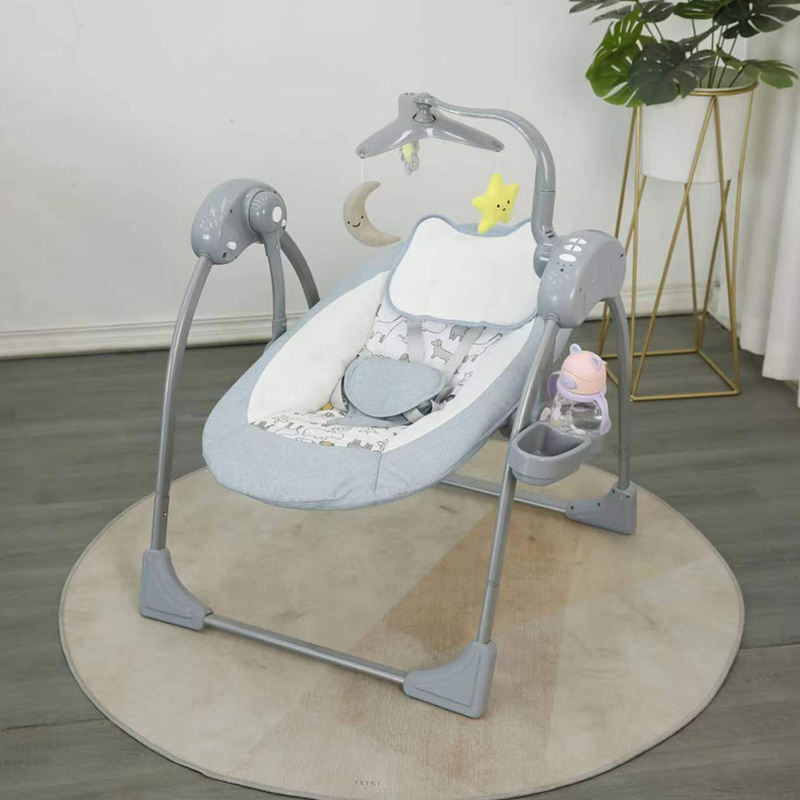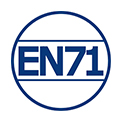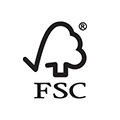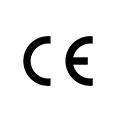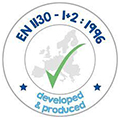Feeding chairs are an essential piece of furniture for parents with infants and toddlers. They provide a safe and comfortable space for your little one to enjoy their meals.
In this comprehensive guide, we will explore everything you need to know about baby feeding chairs, from their importance to the different types available and how to choose the perfect one for your little one.
Is a Baby Feeding Chair a Necessity?
As a new parent, you may wonder if a feeding chair for babies is a necessity or just an additional expense. I must sincerely tell you that a feeding chair is indeed not a necessity for a child’s growth.
Parents can also choose other feeding options, such as feeding directly on the lap or using a portable booster seat.
While not an absolute necessity, many parents find that an infant chair provides numerous benefits that make feeding sessions easier and more enjoyable for both parent and child. Based on the perspective of science and easy care of children’s eating, it is still a recommended baby furniture item.
Modern high chairs are designed with safety in mind. They typically come equipped with harnesses or straps to secure the baby in place, reducing the risk of falls or accidents during feeding sessions.
Babies may lack the muscle control and stability needed to sit upright unsupported, especially during the early stages of their development. Feeding chairs offer proper support and positioning, promoting good posture and ensuring that the baby remains comfortable throughout the feeding process.
When Baby Should Use the Baby Feeding Chair?
Babies can begin using a high chair when they start showing signs of readiness for solid foods, typically around 4 to 6 months of age. But you must be confident that your baby has adequate head and neck control before you can safely place them in a chair.
What Distinguishes a 3-Point Harness from a 5-Point Harness?
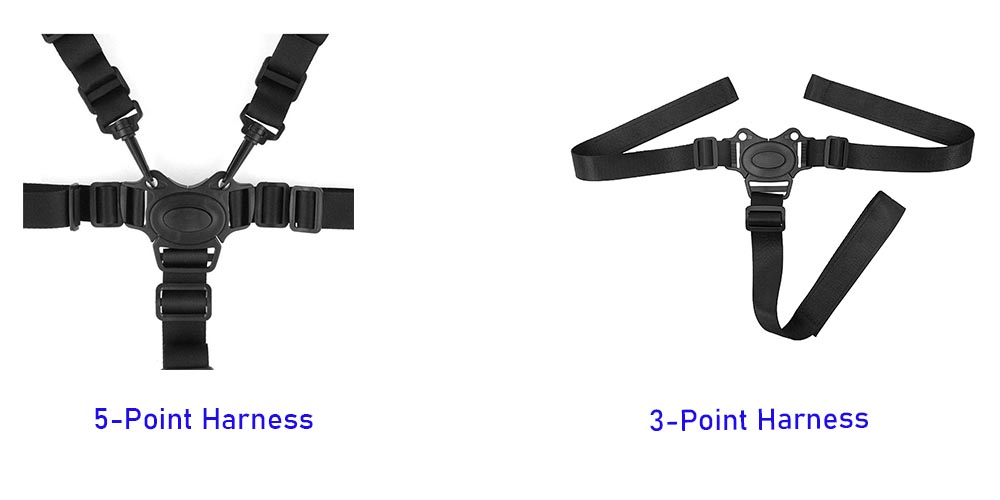
When choosing highchairs for toddlers, you will come across chairs with either a 3-point or a 5-point harness. A 3-point harness and a 5-point harness are both types of safety harness systems commonly used in child restraints, including feeding chairs, car seats, strollers, and highchairs.
3-Point Harness
A 3-point harness consists of three attachment points: one at each shoulder and one between the legs. The shoulder straps come together at a central buckle located at the child’s waist or midsection.
This type of harness provides basic restraint by securing the child’s upper body and preventing them from leaning or falling forward. It is commonly found in booster seats and provides basic security and stability.
5-Point Harness
A 5-point harness consists of five attachment points: two at the shoulders, two at the hips or waist, and one between the legs. In addition to the shoulder straps, the harness includes two additional straps that fasten across the child’s hips or waist, creating a secure five-point configuration.
The central buckle typically features a five-point configuration, with separate buckles for each shoulder strap, each hip strap, and the crotch strap.
This type of harness provides more comprehensive restraint by securing the child’s upper body, lower body, and pelvis, distributing impact forces more evenly in the event of a collision or sudden stop.
It is typically found in highchairs and provides enhanced support and protection, especially for younger babies and toddlers.
The choice between a 3-point and a 5-point harness depends on your child’s age, size, and developmental stage. For younger babies or those who require more support, a best feeding high chair with a 5-point harness is recommended.
How to Scientifically Use a Baby Feeding Chair?
1. Before Use
The chair should be placed on a stable surface, such as a flat floor or a sturdy table.
If using an infant food chair with a tray, attach the tray securely to the chair and adjust it to the appropriate position for feeding.
If your feeding chair is adjustable in height, set it to a level that allows the caregiver to feed the baby comfortably without straining their back or arms.
2. During Use
Position the baby in an upright seated posture with their feet flat on the surface and their back well-supported against the chair’s backrest.
The harness should be snug but not too tight, allowing your baby to move comfortably while preventing it from slipping or sliding out of the chair.
Use soft cushions or inserts if necessary to provide additional support and padding for your baby’s back and bottom.
Encourage your baby to explore and interact with their food during feeding sessions. Offer praise and positive reinforcement for their efforts, even if they make a mess or struggle with self-feeding.
3. After Use
Maintain proper hygiene practices by regularly cleaning and sanitizing the feeding chair, including all surfaces, straps, and attachments.
As your baby grows and develops, adjust the feeding chair settings to accommodate their changing needs. Gradually transition from spoon-feeding to self-feeding as your baby develops the motor skills and coordination necessary to feed independently.
What Types of Baby Feeding Chairs Are There?

1. Traditional Highchairs
These are standalone chairs with a high backrest, footrest, and a tray for meals. They often have adjustable height and recline positions, making them suitable for infants and toddlers of different ages.
2. Convertible Highchairs
Convertible highchairs can transform into different configurations as your child grows. They can be used as a traditional highchair, a booster seat, or even a regular chair for older children.
3. Portable Highchairs
Portable highchairs are lightweight and foldable, making them ideal for travel or dining out. Folding infant high chair can be easily carried in a bag and attached to a regular chair, providing a safe and familiar space for your child to eat.
4. Hook-On Highchairs
Hook-on highchairs attach directly to a table or countertop, saving space and offering a convenient dining solution. They are suitable for older babies and toddlers who can sit upright without assistance.
5. Booster Seats
Booster seats elevate your child to the appropriate height for mealtimes, allowing them to sit at the table with the rest of the family. They can be used with or without a tray, depending on your preferences and the age of your child.
6. Multi-Functional Chair
Some modern high chairs are designed to serve multiple purposes beyond feeding, such as lounging, playing, or resting. These multi-functional chairs may feature adjustable recline positions, vibration settings, or rocking motions to accommodate different activities and preferences.
Top 10 Baby Feeding Chair Brands
Choosing the right baby high chair brand can significantly impact the safety, comfort, and overall feeding experience for your child. Here are ten reputable brands known for their quality and innovative feeding chair designs:
| Brand | Features |
| Clafbebe | Clafbebe offers a wide range of high-quality baby high chairs and wooden baby chairs, and their products are made from non-toxic, environmentally friendly materials. Featuring an innovative design with user-friendly features, it’s made with the modern parent and baby in mind, and support custom baby chairs. |
| Graco | Graco offers a wide range of toddler high chairs, including traditional highchairs, booster seats, and hook-on chairs. Their chairs are known for their durability, safety features, and affordability. |
| Fisher-Price | Fisher-Price specializes in baby gear and toys, including feeding chairs with features such as adjustable height, recline positions, and interactive toys to keep babies entertained during meal times. |
| Chicco | Chicco is known for its high-quality baby products, including feeding chairs with adjustable height, recline positions, and removable trays for easy cleaning. Their folding infant high chairs prioritize safety and comfort, with features such as padded seats and secure harnesses. |
| Evenflo | Evenflo manufactures a variety of high-rated high chairs, from traditional highchairs to convertible designs and portable booster seats. Their chairs feature practical and innovative designs, such as fold-flat storage, machine-washable components, and easy-to-clean surfaces. |
| Peg Perego | Peg Perego offers premium-quality feeding chairs with stylish designs and advanced features. Their modern high chairs often feature adjustable height and recline settings, leatherette upholstery, and intuitive controls for ease of use. |
| Joovy | Joovy specializes in baby gear and accessories, including best feeding high chairs with practical features such as adjustable trays, easy-clean surfaces, and compact folding for storage or travel. |
| 4moms | 4moms designs innovative and high-tech baby products, including feeding chairs with features such as magnetic tray attachment, one-handed tray removal, and easy-clean surfaces. Their infant feeding chairs prioritize convenience and modern design. |
| BabyBjörn | BabyBjörn offers feeding chairs with minimalist Scandinavian design and practical features. Their best feeding chairs are known for their ergonomic design, easy-to-clean surfaces, and lightweight and portable construction. |
| Safety 1st | Safety 1st specializes in baby safety products, including toddler high chairs with features such as secure harnesses, easy-clean surfaces, and space-saving designs. |
How to Choose a Baby Feeding Chair?
1. Safety Features
- Look for a high chair with sturdy construction and safety features such as a secure harness or strap.
- Check for certifications or safety standards compliance.
2. Age and Size Suitability
- Consider your child’s age, size, and developmental stage when selecting a best feeding high chair.
3. Adjustability
- Opt for a feeding chair with adjustable features such as height settings, recline positions, and tray positions.
- Adjustable features also allow the chair to adapt to different table heights or seating arrangements.
4. Ease of Cleaning
- Choose a feeding chair with removable, easy-to-clean components such as trays, seat cushions, and harnesses for quick and convenient cleanup after meals.
- Look for materials that are stain-resistant and machine-washable.
5. Comfort and Support
- Selecting a feeding chair with padded seat cushions, ergonomic design, and supportive backrest.
6. Portability and Storage
- If you have limited space or travel frequently, opt for a lightweight and portable chair that is easy to fold or collapse for storage and transport.
- Look for features such as compact folding mechanisms or detachable components for added convenience.
What to Do When a Child Doesn’t Like the Baby Feeding Chair?
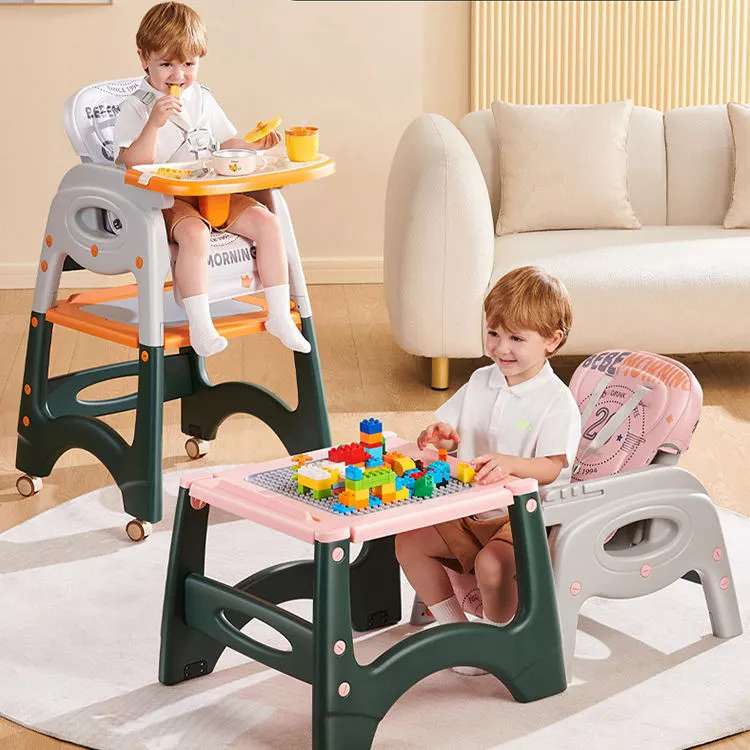
Identify the Issue: Take some time to observe your child’s behavior and try to identify the specific reasons why they may not like the infant eating seat. It could be due to discomfort, fear, or simply a dislike of being confined.
Offer Choices: Provide your child with some degree of autonomy by offering choices within the feeding chair setup. For example, let them choose between different seating positions, adjust the height of the chair if possible, or allow them to select their favorite utensils or dishes.
Make it Fun: Incorporate fun and interactive elements, such as colorful placemats, playful utensils, or engaging conversation.
Gradual Exposure: Start by allowing them to sit in the chair for short periods during playtime or snack time, gradually increasing the duration over time.
Positive Reinforcement: Offer praise and positive reinforcement when your child uses the high chair successfully, even if it’s just for a short time.
Model Behavior: Set a positive example by using the feeding chair yourself or demonstrating how to sit comfortably and safely in the chair.
Address Concerns: If your child expresses specific concerns or fears related to the feeding chair, take the time to listen and validate their feelings.
Can I Use a Booster Seat Instead of a Highchair?
Yes, you can use a booster seat as an alternative to a traditional highchair. Booster seats are portable, compact, and typically attached to a regular dining chair to elevate your child to the appropriate height for mealtimes. They are especially useful when you have limited space or prefer a more versatile option.
However, it’s important to consider your child’s age, size, and developmental stage when deciding between a highchair and a booster seat. Highchairs provide more support and safety features, such as a larger tray, footrest, and a five-point harness, which can be essential for younger babies and toddlers who may still require more assistance and supervision during mealtimes.
On the other hand, booster seats are better suited for older children who have outgrown a highchair but still need a little boost to reach the table comfortably. They are also convenient for traveling or dining out, as they can easily be folded and transported.
Tips for Safe Use of Baby Feeding Chairs
1. Prevent Falls or Tipping Over
Babies and toddlers may lean or wiggle in the feeding chair, increasing the risk of falls or tipping over.
Always use the safety harness or straps provided with the chair to secure your child in place. Ensure that the chair is placed on a stable surface and never leave your child unattended while seated in the chair.
2. Prevent Entanglement or Entrapment
Loose clothing, straps, or accessories can pose a risk of entanglement or entrapment, leading to injuries or strangulation.
Avoid dressing your child in loose clothing or accessories that could get caught in the feeding chair. Regularly inspect the chair for any signs of wear or damage to straps or harnesses and replace them as needed.
3. Prevent Choking Hazards
Small parts or pieces of food may pose a choking hazard if not properly managed during feeding.
Cut food into small, bite-sized pieces to reduce the risk of choking. Supervise your child closely while they are eating and discourage them from putting large chunks of food into their mouth at once.
4. Prevent Pinching or Finger Entrapment
Moving parts or adjustable features of the feeding chair may pose a risk of pinching or finger entrapment.
Be cautious when adjusting or folding the feeding chair to avoid trapping fingers or hands.
Conclusion
In conclusion, a feeding chair is valuable to your baby’s mealtime routine. It provides a safe and supportive space for your little one to enjoy their meals, promotes good posture and independence, and establishes a sense of routine and structure.
With the best-feeding high chair, you can create positive and enjoyable mealtimes for your baby, setting the foundation for healthy eating habits and optimal development.
Recommended Related Articles:


